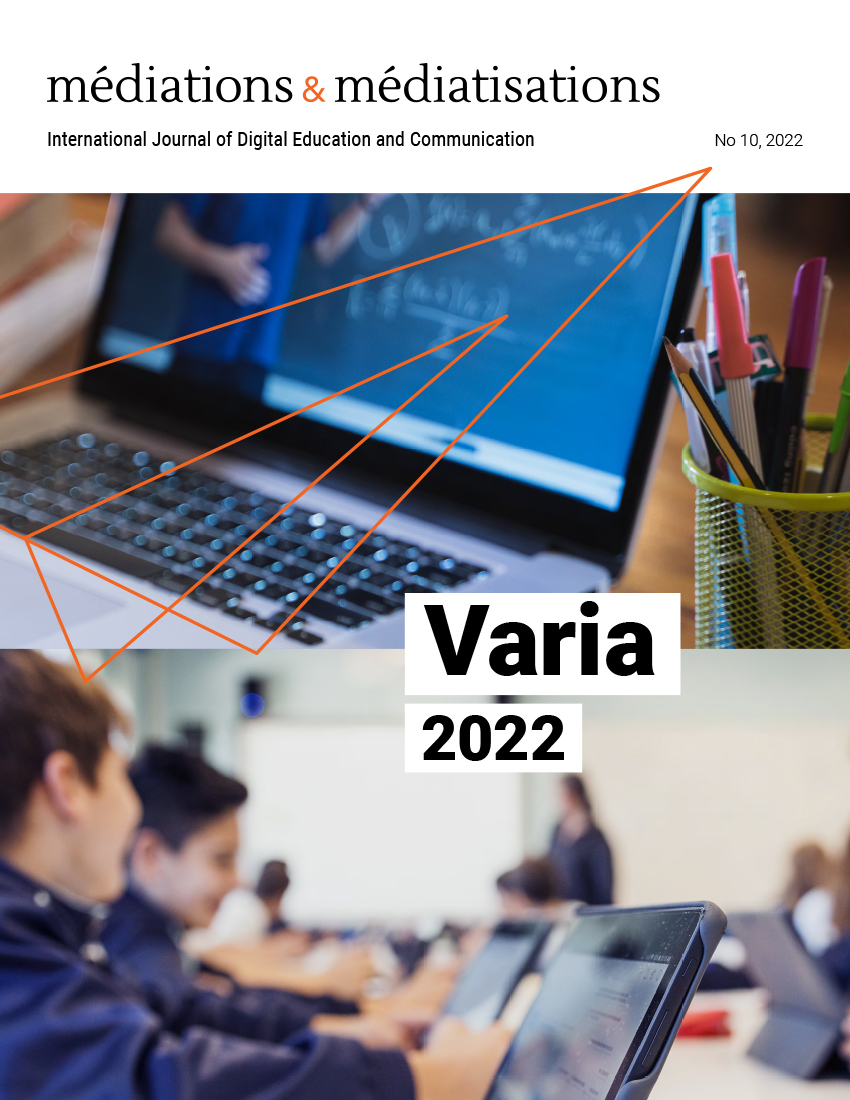On the Risk of Multiplying Stakeholders During the Design of a Computer-based Learning Environment: The Case of the CNEC
Main Article Content
Abstract
To foster the adoption of computer-based learning environments in the classroom, based on both research and user tests, the French State funded via theeFRAN projects, heterogeneous consortia featuring EdTech companies, teachers, and research laboratories. While at first glance, the composition of such consortia suggests that all the skills required to reach these objectives are all present, divergences among stakeholders may have hindered the design process on various occasions. We illustrate this hypothesis using the case study: Les Savanturiers du Numérique, responsible for the design of the Student-Researcher Digital Notebook (SRDN). Differences of perspectives and conflicting interests, as well as the initial lack of rules regarding the collaboration within the consortium led to a series of consensus that ultimately hindered the utility and usability of the learning environment. Based on a longitudinal analysis of the entire design process, we offer an analysis of the design process issues associated with the multiplicity of visions expressed.
Downloads
Article Details
References
Carosin, E., et Demeuse, M. (2018). Les Savanturiers – Rapport d’évaluation final (p. 110). https://hal.archives-ouvertes.fr/hal-01962598
Cisel, M., Beauné, A, Bernard, F., Voulgre, E., et Baron, G. (2017). Analyse d’un outil de décision mobilisé dans la conception d’un EIAH. Dans Actes de la 8e conférence sur les Environnements Informatiques pour l’Apprentissage Humain, 382-385. https://hal.archives-ouvertes.fr/hal-01634157
Cisel, M., et Baron, G.-L. (2018). Conception d’un EIAH à destination du programme Savanturiers : difficultés engendrées par une approche inductiviste de la spécification des besoins. Dans Actes de la 3e conférence École et Technologies de l’Information et de la Communication, Paris, 27-29 juin 2018. https://hal.archives-ouvertes.fr/hal-03051552/
Cisel, M., et Baron, G.-L. (2019a). Utilisation de tableaux de bord numériques pour l’évaluation des compétences scolaires : Une étude de cas. Questions Vives. Recherches en éducation, 31. https://doi.org/10.4000/questionsvives.3883
Cisel, M., et Baron, G. (2019b). Vers des intelligences artificielles pour l’enseignement du raisonnement scientifique. Dans Séminaire Inter-Laboratoires sur l’Éducation Scientifique et Technologique. Patras, 3-5 avril 2019. https://hal.archives-ouvertes.fr/hal-02523391/
Cukurova, M., Luckin, R., et Clark-Wilson, A. (2019). Creating the golden triangle of evidence-informed education technology with EDUCATE. British Journal of Educational Technology, 50(2), 490-504. https://doi.org/10.1111/bjet.12727
Jean-Daubias, S. (2004, octobre). De l’intégration de chercheurs, d’experts, d’enseignants et d’apprenants à la conception d’EIAH. 290-297. https://edutice.archives-ouvertes.fr/edutice-00000708/
Jeantet, A. (1998). Les objets intermédiaires dans la conception. Éléments pour une sociologie des processus de conception. Sociologie du travail, 40(3), 291-316.
Herranen, J., et Aksela, M. (2019). Student-question-based inquiry in science education. Studies in Science Education, 55(1), 1-36. https://doi.org/10.1080/03057267.2019.1658059
Luengo, V. (1999). Analyse et prise en compte des contraintes didactiques et informatiques dans la conception et le développement du micromonde de preuve Cabri-Euclide. Sciences et Techniques Éducatives, 6(2), 27.
Moons, J., et De Backer, C. (2013). The design and pilot evaluation of an interactive learning environment for introductory programming influenced by cognitive load theory and constructivism. Computers & Education, 60(1), 368-384. https://doi.org/10.1016/j.compedu.2012.08.009
Pedaste, M., Mäeots, M., Siiman, L. A., de Jong, T., van Riesen, S. A. N., Kamp, E. T., Manoli, C. C., Zacharia, Z. C. Tsourlidaki, E. (2015). Phases of inquiry-based learning: Definitions and the inquiry cycle. Educational Research Review, 14, 47-61. https://doi.org/10.1016/j.edurev.2015.02.003
Pirone, F. (2018) « Les Savanturiers de la sociologie ». De la recherche en « éducation par la recherche ». Diversité (192).
Penneman, J., De Croix, S., Dellisse, S., Dufays, J., Dumay, X., Dupriez, V., Galand, B., et Wyns, M. (2016). Outils didactiques et changement pédagogique : analyse longitudinale de l’appropriation de l’outil Lirécrire par des enseignants du secondaire. Revue française de pédagogie, 197(4), 79-98. https://doi.org/10.4000/rfp.5165
Quintana, C., Reiser, B., J., Davis, E., A., Krajcik, J., Fretz, E., et Duncan, R., G. (2004). A scaffolding design framework for software to support science inquiry. Journal of the Learning Sciences, 13(3), 337-386.
Scardamalia, M. et Bereiter, C. (2006). Knowledge Building: Theory, Pedagogy, and Technology. Dans K. Sawyer (dir), Cambridge Handbook of the Learning Sciences (pp. 97-118). New York: Cambridge University Press.
Slotta, J. D., et Linn, M. C. (2009). WISE Science: Web-Based Inquiry in the Classroom. New York, NY, USA: Teachers College Press.
Tricot, A., Plégat-Soutjis, F., Camps, J.-F., Amiel, A., Lutz, G. et Morcillo, A. (2003, avril). Utilité, utilisabilité, acceptabilité : interpréter les relations entre trois dimensions de l’évaluation des EIAH. Dans Cyrille Desmoulins, Pascal Marquet, Denis Bouhineau (dir.), Actes de la conférence Environnements Informatiques pour l’Apprentissage Humain (EIAH 2003) (p. 391-402). Strasbourg, France.
Tripp, S. D., et Bichelmeyer, B. (1990). Rapid prototyping: An alternative instructional design strategy. Educational Technology Research and Development, 38(1), 31-44.
Van Joolingen, W. R., et De Jong, T. (1991). Supporting hypothesis generation by learners exploring an interactive computer simulation. Instructional Science, 20(5-6), 389-404.
Weller, M. (2018). Twenty years of EdTech. Educause Review Online, 53(4), 34-48. https://er.educause.edu/articles/2018/7/twenty-years-of-edtech

